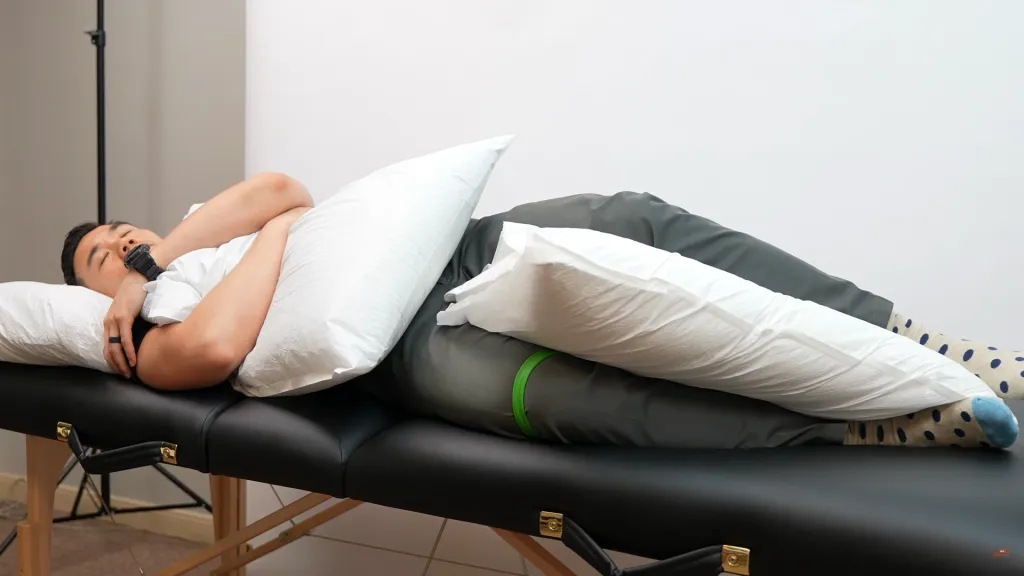How Can You Get Better Rest During Knee Surgery Recovery?
One of the most important factors that determine how fast you recover is sleep. Your body recovers the most during this time, and if you don’t get enough of it your energy levels will drop and the rehab process just becomes more difficult.
Your surgeon might have a specific sleep position that they want you in after surgery and for those specific situations you definitely want to follow your surgeon’s protocols. However, if you don’t have specific guidelines from your surging on sleeping positions, we’re going to go over the best practices.
If you would prefer to watch a video explaining the best sleep positions during recovery you can watch it here.
Side Sleeping
The first position that we’re going to be talking about is sleeping on your side. One of the most common questions we get asked in the clinic is: do I sleep with the surgical leg on the bottom or on the top?
It really depends on what gives you the better quality of sleep.
If you were to sleep on the surgical side, what you want to do is place a pillow between the knees to keep the hips, knees and ankles aligned. You can keep the surgical knee bent or straight, depending on your comfort level.
You don’t want a pillow that’s too soft or small. Otherwise, the top leg can roll over or the weight of your top leg can flatten the pillow and cause misalignment of the joints.
If your bed is soft, and you find yourself sinking in, you might want to put a small pillow under your waist to keep your spine in a neutral position. You can also stack some pillows and put them under your top arm to prevent it from rolling over.

Quarter Turn Position
Some of you can’t tolerate this position, because the surgical knee is just way too sensitive. So another position you can try is what I call the quarter turn for this position.
You will still have the pillows in the same place, to keep the hip, knees, and ankles aligned. The only difference is that your body is turning diagonal to offset pressure on the bottom leg. When you’re in this position, you can also use a pillow behind your back to ensure that you’re protected from both ends of your body.

Back Sleeping
If you’re not a side sleeper, another option is sleeping on your back. The main thing to be aware of in this position is when you sleep on your back, you want to support the surgical knee without causing a knee flexion contracture.
A knee flexion contracture is when the knee is stuck in a bent position. The way you prevent this from happening is by putting a pillow not just under the knee, but also under the calf as well.

Swelling Management
Something else you might want to consider in the sleeping position is swelling management.
One of the best ways you can do that is to get a wedge in conjunction with the pillow that we just mentioned in this position. When your knee is fully supported and your feet are higher than your hips, the swelling in your knee will slowly decrease.
Think of your leg like a bottle of water. The top part is the hip, the middle part is your knee, and the cap is your feet. There’s going to be more pressure in the knee because of the post surgical swelling and inflammation.

When you elevate the leg, you’re allowing gravity to do its job to get the fluid out of the feet, the knee, and back towards the hip. If you’re in this position before bed, I would throw on an ice pack or heat pack around the knee area to further relax the muscles.
Stomach Sleeping
The next position that we’re going to address is stomach sleeping. This is usually not the most common position people sleep in after surgery because they have a hard time tolerating long periods of pressure on the knee incision site.
If you were to sleep on your stomach, I would support the whole leg from the thigh down to the shins. Make sure the pillows are not too thick, so you won’t hyperextend the low back and have pressure there. You want the legs slightly elevated, where the foot is above hip level for swelling management.

If you have a soft bed, you might want to put a pillow under your torso so that you don’t sink into the bed and cause excess pressure.
Get The TKR Recovery Help You Need
We just went through the best sleeping positions after total knee replacement surgery.
The most important thing to keep in mind is to choose the one that works best for you and gives you maximum sleep quality. In the grand scheme of things, sleep is just one piece to the puzzle to maximize your knee rehab.
You still have to do your exercises, nourish your body with quality food, work with your physical therapist, and of course, follow your surgeon’s protocol.
If you have any questions, please click the button below and my team will get back to you as soon as possible.

